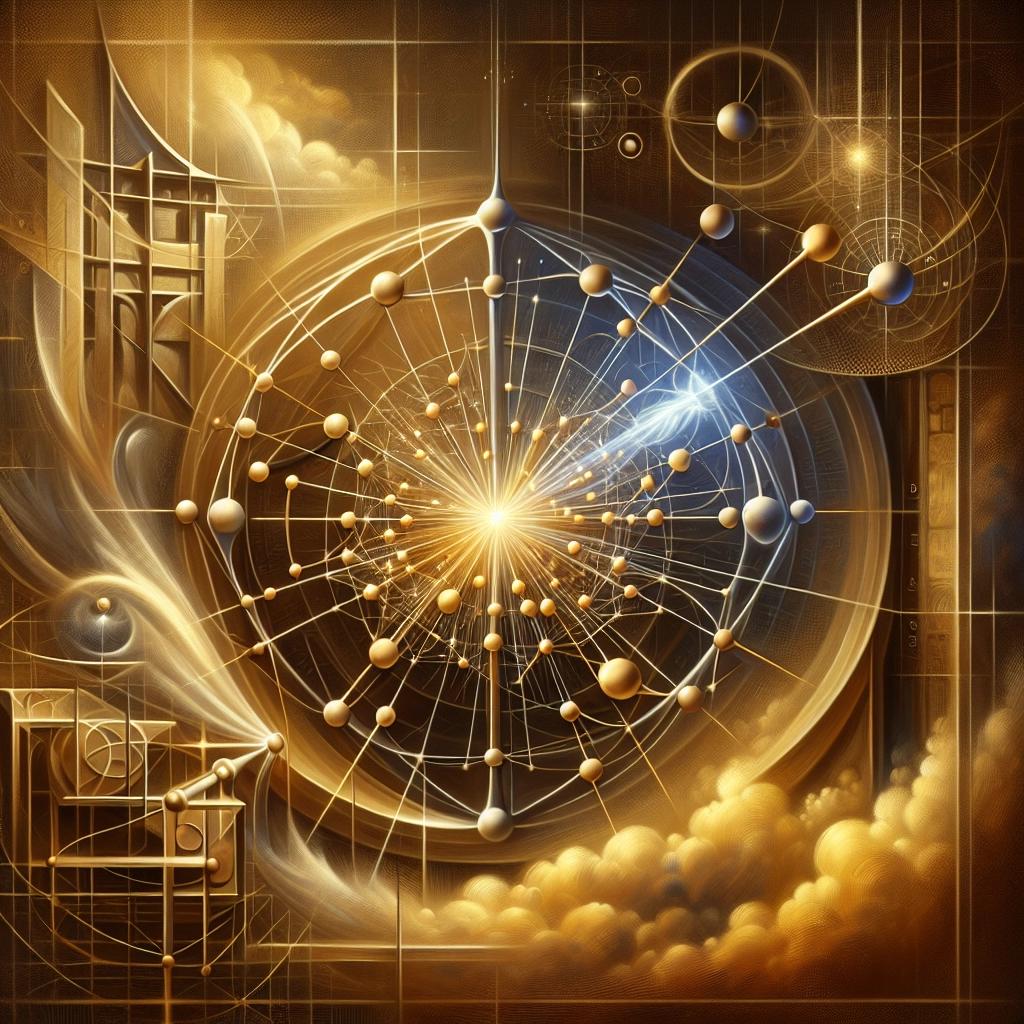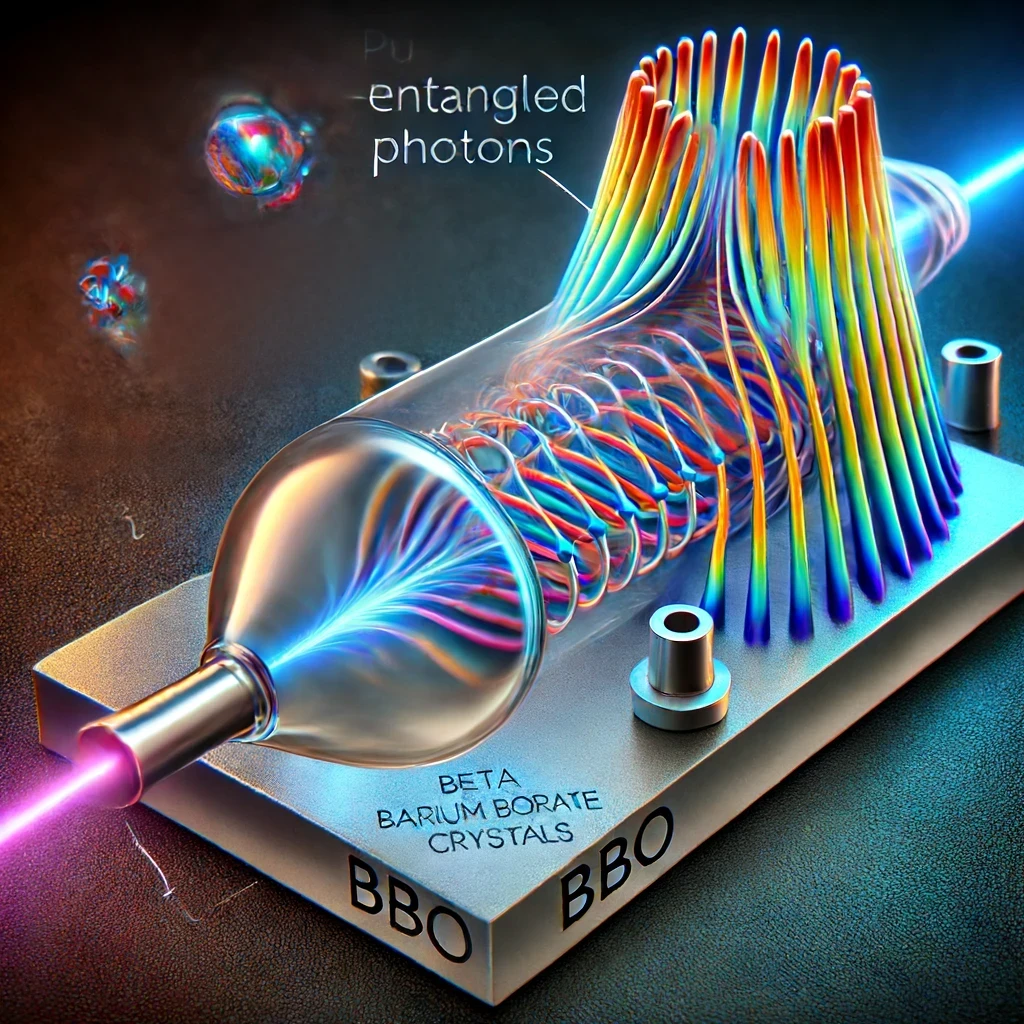Entangled Photon Sources and Detectors: Unlocking the Potential of Quantum Mechanics
 Quantum Cyber Solutions
Quantum Cyber Solutions

Published on
Wednesday, June 12, 2024
Entangled Photon Sources and Detectors: Unlocking the Potential of Quantum Mechanics
========================================================================================
Authors

Name
Eric deQuevedo 😄
Twitter
🌌 Introduction: Entangled Photon Sources and Detectors
Entanglement is a captivating quantum mechanical phenomenon where the state of a multi-particle system cannot be described independently of the state of the other particles, even when the particles are separated by vast distances. This article delves into the generation and detection of entangled photon pairs, focusing on the widely used technique of spontaneous parametric downconversion (SPDC) and its implications for quantum technologies.
✨ Understanding Entanglement
In the realm of quantum mechanics, entanglement refers to a state where two or more particles become interconnected in such a way that the state of one particle instantaneously influences the state of the other, regardless of the distance between them. This non-classical correlation defies our intuitive understanding of locality and has profound implications for quantum information science, enabling groundbreaking applications such as quantum cryptography, quantum teleportation, and quantum computing.
🌀 Bell States: The Building Blocks of Entanglement
The entanglement of two qubits (two-level quantum systems) can be elegantly represented by Bell states, named after the physicist John Stewart Bell. These states exhibit maximum entanglement and are defined as follows:
∣Ψ+⟩=12(∣H⟩∣V⟩+∣V⟩∣H⟩)|\Psi^+\rangle = \frac{1}{\sqrt{2}} (|H\rangle|V\rangle + |V\rangle|H\rangle)∣Ψ+⟩\=21(∣H⟩∣V⟩+∣V⟩∣H⟩)
∣Ψ−⟩=12(∣H⟩∣V⟩−∣V⟩∣H⟩)|\Psi^-\rangle = \frac{1}{\sqrt{2}} (|H\rangle|V\rangle - |V\rangle|H\rangle)∣Ψ−⟩\=21(∣H⟩∣V⟩−∣V⟩∣H⟩)
∣Φ+⟩=12(∣H⟩∣H⟩+∣V⟩∣V⟩)|\Phi^+\rangle = \frac{1}{\sqrt{2}} (|H\rangle|H\rangle + |V\rangle|V\rangle)∣Φ+⟩\=21(∣H⟩∣H⟩+∣V⟩∣V⟩)
∣Φ−⟩=12(∣H⟩∣H⟩−∣V⟩∣V⟩)|\Phi^-\rangle = \frac{1}{\sqrt{2}} (|H\rangle|H\rangle - |V\rangle|V\rangle)∣Φ−⟩\=21(∣H⟩∣H⟩−∣V⟩∣V⟩)
where
∣H⟩|H\rangle∣H⟩
and
∣V⟩|V\rangle∣V⟩
represent the horizontal and vertical polarization states of a photon, respectively.
🔍 Generating Entangled Photons: Spontaneous Parametric Downconversion (SPDC)
🌟 The Magic of SPDC
Spontaneous parametric downconversion (SPDC) is a non-linear optical process that lies at the heart of entangled photon generation. In SPDC, a high-energy photon from a pump laser interacts with a non-linear crystal, leading to the creation of two lower-energy photons, known as the signal and idler photons. This process obeys the fundamental principles of energy and momentum conservation:
- Energy Conservation:
ωp=ωs+ωi\omega_p = \omega_s + \omega_iωp\=ωs+ωi
- Momentum Conservation:
k⃗p=k⃗s+k⃗i\vec{k}_p = \vec{k}_s + \vec{k}_ikp\=ks+ki
where
ωp\omega_pωp
,
ωs\omega_sωs
, and
ωi\omega_iωi
represent the frequencies of the pump, signal, and idler photons, and
k⃗p\vec{k}_pkp
,
k⃗s\vec{k}_sks
, and
k⃗i\vec{k}_iki
denote their respective wave vectors.
📸 Types of SPDC: Type-I and Type-II
SPDC can be classified into two main types based on the polarization of the generated photons:
Type-I SPDC: In Type-I SPDC, the signal and idler photons possess the same polarization, either both ordinary or both extraordinary.
Type-II SPDC: In Type-II SPDC, the signal and idler photons have orthogonal polarizations, with one being ordinary and the other extraordinary.
The choice between Type-I and Type-II SPDC depends on the desired entangled state and the specific application.
🌀 Polarization-Entangled Photons with BBO Crystals
Beta barium borate (BBO) crystals are widely employed non-linear materials for SPDC due to their high non-linearity and birefringence properties. When a pump photon enters a properly oriented BBO crystal, it undergoes downconversion, giving rise to a pair of entangled photons with orthogonal polarizations. The emitted photons form two cones, one for each polarization, and their correlation.

By carefully selecting photons from the regions where these cones intersect, we can generate polarization-entangled states of the form:
∣Ψ+⟩=12(∣H⟩∣V⟩+∣V⟩∣H⟩)|\Psi^+\rangle = \frac{1}{\sqrt{2}} (|H\rangle|V\rangle + |V\rangle|H\rangle)∣Ψ+⟩\=21(∣H⟩∣V⟩+∣V⟩∣H⟩)
This entangled state serves as a fundamental resource for various quantum protocols and experiments.
🔄 Generating All Four Bell States
While the
∣Ψ+⟩|\Psi^+\rangle∣Ψ+⟩
state is readily obtained from SPDC, generating the remaining three Bell states requires additional manipulations using optical elements such as waveplates. By introducing precise phase shifts and swapping polarizations, we can transform
∣Ψ+⟩|\Psi^+\rangle∣Ψ+⟩
into the other Bell states.
📡 Detection of Bell States
Detecting and distinguishing between the four Bell states is a crucial aspect of quantum information processing. It typically involves intricate setups consisting of beam splitters, polarizers, and single-photon detectors that can perform conditional measurements based on the quantum state of the photons. One common approach employs a combination of a controlled-NOT (CNOT) gate and a Hadamard gate to reveal the underlying Bell state through the measurement outcomes.
🔬 Example Setup for Bell State Detection
A typical setup for Bell state detection consists of the following components:
CNOT Gate: The CNOT gate performs a conditional operation on the target qubit based on the state of the control qubit. It entangles the two qubits further, enabling the detection of the specific Bell state.
Hadamard Gate: The Hadamard gate applies a superposition transformation to the qubits, converting the entangled state into a separable state that can be measured individually.
Measurement: Finally, the qubits are measured in the computational basis (e.g.,
∣0⟩|0\rangle∣0⟩
and
∣1⟩|1\rangle∣1⟩
), and the measurement outcomes are used to determine the type of Bell state.
📊 Protocol for Bell State Detection
The protocol for detecting a specific Bell state, such as
∣Ψ+⟩|\Psi^+\rangle∣Ψ+⟩
, can be summarized as follows:
- Initial State: The entangled photon pair is prepared in the
∣Ψ+⟩|\Psi^+\rangle∣Ψ+⟩
state.
- CNOT Gate: The CNOT gate is applied to the photon pair, entangling them further.
- Hadamard Gate: The Hadamard gate is applied to one of the photons, transforming the entangled state into a separable state.
- Measurement: Both photons are measured in the computational basis, and the measurement outcomes are analyzed to determine the presence of the
∣Ψ+⟩|\Psi^+\rangle∣Ψ+⟩
state.
By extending this protocol to other Bell states and incorporating additional optical elements, we can reliably detect and distinguish between the four Bell states.
💡 Applications of Entangled Photons
Entangled photons have found numerous applications in the field of quantum information science, revolutionizing the way we process, transmit, and secure information. Some notable applications include:
Quantum Cryptography: Entangled photons form the backbone of quantum key distribution (QKD) protocols, enabling the secure exchange of cryptographic keys between distant parties. The inherent properties of entanglement ensure that any attempt to intercept or eavesdrop on the communication can be detected, making QKD virtually unbreakable.
Quantum Teleportation: Entanglement allows the transfer of quantum information between two distant locations without physically transmitting the quantum state. By exploiting the correlations between entangled photons, quantum teleportation has been demonstrated over increasingly longer distances, paving the way for future quantum communication networks.
Quantum Computing: Entangled photons can serve as qubits in photonic quantum computing architectures. The ability to generate, manipulate, and detect entangled photons is essential for realizing scalable quantum computers that can solve complex problems beyond the capabilities of classical computers.
Quantum Metrology: Entangled photons can enhance the precision and sensitivity of measurements, surpassing the limits imposed by classical techniques. By harnessing the correlations between entangled photons, quantum metrology enables ultra-precise measurements of physical quantities such as time, distance, and magnetic fields.
🌐 Conclusion: Harnessing the Power of Entanglement
Entangled photon sources and detectors lie at the heart of quantum information science, enabling us to harness the mind-bending properties of quantum mechanics for revolutionary applications. Spontaneous parametric downconversion (SPDC) has emerged as a powerful technique for generating entangled photon pairs, while sophisticated detection schemes allow us to distinguish between the different Bell states.
As we continue to push the boundaries of quantum technologies, mastering the generation, manipulation, and detection of entangled photons will be crucial. From secure communication and quantum computing to ultra-precise measurements and fundamental physics experiments, entangled photons hold the key to unlocking the full potential of quantum mechanics.
By delving into the fascinating world of entangled photon sources and detectors, we embark on a journey that promises to transform the way we process information and interact with the quantum realm. As we unravel the mysteries of entanglement and develop cutting-edge quantum technologies, we stand on the brink of a new era in science and technology, where the once-impossible becomes possible through the power of quantum mechanics.
Discuss on Twitter • View on GitHub
Tags
Quantum Mechanics
Photon Entanglement
Spontaneous Parametric Downconversion
Bell States
Quantum Cryptography
Quantum Information Science
Previous Article
Bells Inequality and Its Implications
Next Article
Quantum Teleportation and Entanglement: Bridging Space with Quantum Information
Subscribe to my newsletter
Read articles from Quantum Cyber Solutions directly inside your inbox. Subscribe to the newsletter, and don't miss out.
Written by
